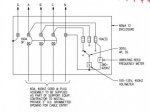Gilf
Member
- Location
- Ankara, Turkey
Hi,
I have taken over this project and I am fairly new at 400 Hz systems.
I have the below detail of a 400 Hz service bay power supply. The supply box has an 100 A breaker in it (see image) and it feeds a 60A 400 Hz cord & plug assembly. Up to this point, it's all ok. However the breaker that feeds the power supply box is rated 80A in the design (also a 400Hz panel). To my knowledge this is code violation of selective coordination. I think that the 80A breaker is sized to load and the 100A in the detail was not thought about.
Does selective coordination apply differently to 400 Hz system. Or is this simply incorrect?
I have taken over this project and I am fairly new at 400 Hz systems.
I have the below detail of a 400 Hz service bay power supply. The supply box has an 100 A breaker in it (see image) and it feeds a 60A 400 Hz cord & plug assembly. Up to this point, it's all ok. However the breaker that feeds the power supply box is rated 80A in the design (also a 400Hz panel). To my knowledge this is code violation of selective coordination. I think that the 80A breaker is sized to load and the 100A in the detail was not thought about.
Does selective coordination apply differently to 400 Hz system. Or is this simply incorrect?


